Design, Synthesis and Biochemical Evaluation of Novel Ethanoanthracenes and Related Compounds to Target Burkitt's Lymphoma
- PMID: 31963567
- PMCID: PMC7168933
- DOI: 10.3390/ph13010016
Design, Synthesis and Biochemical Evaluation of Novel Ethanoanthracenes and Related Compounds to Target Burkitt's Lymphoma
Abstract
Lymphomas (cancers of the lymphatic system) account for 12% of malignant diseases worldwide. Burkitt's lymphoma (BL) is a rare form of non-Hodgkin's lymphoma in which the cancer starts in the immune B-cells. We report the synthesis and preliminary studies on the antiproliferative activity of a library of 9,10-dihydro-9,10-ethanoanthracene based compounds structurally related to the antidepressant drug maprotiline against BL cell lines MUTU-1 and DG-75. Structural modifications were achieved by Diels-Alder reaction of the core 9-(2-nitrovinyl)anthracene with number of dienophiles including maleic anhydride, maleimides, acrylonitrile and benzyne. The antiproliferative activity of these compounds was evaluated in BL cell lines EBV- MUTU-1 and EBV+ DG-75 (chemoresistant). The most potent compounds 13j, 15, 16a, 16b, 16c, 16d and 19a displayed IC50 values in the range 0.17-0.38 μM against the BL cell line EBV- MUTU-1 and IC50 values in the range 0.45-0.78 μM against the chemoresistant BL cell line EBV+ DG-75. Compounds 15, 16b and 16c demonstrated potent ROS dependent apoptotic effects on the BL cell lines which were superior to the control drug taxol and showed minimal cytotoxicity to peripheral blood mononuclear cells (PBMCs). The results suggest that this class of compounds merits further investigation as antiproliferative agents for BL.
Keywords: 9,10-dihydro-9,10-ethanoanthracene; Burkitt’s lymphoma; DG-75; MUTU-1; anthracene; apoptosis; maprotiline; nitrostyrene.
Conflict of interest statement
The authors confirm that this article content has no conflict of interest.
Figures
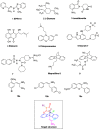
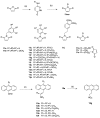
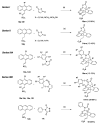


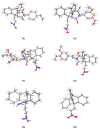
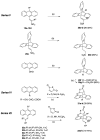

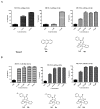







Similar articles
-
Synthesis and Pro-Apoptotic Effects of Nitrovinylanthracenes and Related Compounds in Chronic Lymphocytic Leukaemia (CLL) and Burkitt's Lymphoma (BL).Molecules. 2023 Dec 14;28(24):8095. doi: 10.3390/molecules28248095. Molecules. 2023. PMID: 38138584 Free PMC article.
-
Synthesis and Biochemical Evaluation of Ethanoanthracenes and Related Compounds: Antiproliferative and Pro-Apoptotic Effects in Chronic Lymphocytic Leukemia (CLL).Pharmaceuticals (Basel). 2024 Aug 5;17(8):1034. doi: 10.3390/ph17081034. Pharmaceuticals (Basel). 2024. PMID: 39204139 Free PMC article.
-
Synthesis, Antiproliferative and Pro-Apoptotic Effects of Nitrostyrenes and Related Compounds in Burkitt's Lymphoma.Med Chem. 2018 Feb 6;14(2):181-199. doi: 10.2174/1573406413666171002123907. Med Chem. 2018. PMID: 28969575
-
Synthesis and antiproliferative action of a novel series of maprotiline analogues.Eur J Med Chem. 2014 Jan;71:333-53. doi: 10.1016/j.ejmech.2013.10.076. Epub 2013 Nov 9. Eur J Med Chem. 2014. PMID: 24333581
-
Primary ovarian Burkitt's lymphoma: a rare oncological problem in gynaecology: a review of literature.Arch Gynecol Obstet. 2017 Oct;296(4):653-660. doi: 10.1007/s00404-017-4478-6. Epub 2017 Aug 2. Arch Gynecol Obstet. 2017. PMID: 28770352 Free PMC article. Review.
Cited by
-
Synthesis and Pro-Apoptotic Effects of Nitrovinylanthracenes and Related Compounds in Chronic Lymphocytic Leukaemia (CLL) and Burkitt's Lymphoma (BL).Molecules. 2023 Dec 14;28(24):8095. doi: 10.3390/molecules28248095. Molecules. 2023. PMID: 38138584 Free PMC article.
-
Synthesis and Biochemical Evaluation of Ethanoanthracenes and Related Compounds: Antiproliferative and Pro-Apoptotic Effects in Chronic Lymphocytic Leukemia (CLL).Pharmaceuticals (Basel). 2024 Aug 5;17(8):1034. doi: 10.3390/ph17081034. Pharmaceuticals (Basel). 2024. PMID: 39204139 Free PMC article.
References
-
- National Cancer Registry Ireland . Cancer in Ireland 1994–2016 with Estimates for 2016–2018: Annual Report of the National Cancer Registry. NCRI; Cork, Ireland: 2018.
-
- Anderton E., Yee J., Smith P., Crook T., White R.E., Allday M.J. Two Epstein-Barr virus (EBV) oncoproteins cooperate to repress expression of the proapoptotic tumour-suppressor bim: Clues to the pathogenesis of Burkitt’s lymphoma. Oncogene. 2008;27:421–433. doi: 10.1038/sj.onc.1210668. - DOI - PubMed
-
- Phase II Study of Dose-Adjusted EPOCH-Rituximab in Adults with Untreated Burkitt Lymphoma and C-Myc+ Diffuse Large B-Cell Lymphoma-Full Text View-Clinicaltrials. Gov. [(accessed on 24 October 2019)]; Available online: Http://clinicaltrials.Gov/ct2/show/nct01092182?Term=burkitt+lymphoma&rank=1.
LinkOut - more resources
Full Text Sources

